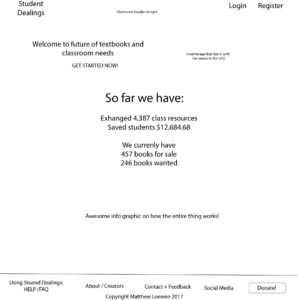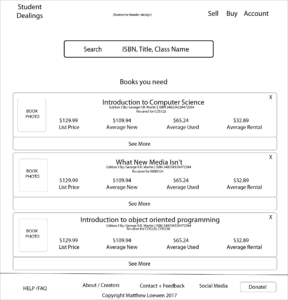Hacktivism Approach — MatthewL B
To see most work please see this Document.
Title: Project Textbook
Sentence Summary: This project aims to allow students no longer require the use of the bookstore or other online retailers.
2-3 paragraphs:
What?
An exchange system immediately focused at the University of Maine campus. This system will match up university attendees with larger scale classroom needs in the goal of saving money. This system will concentrate on supplies such as textbooks and Iclickers over less essential items such as binders, paper, etc. The way this system is to work is by “matching” users with whoever can offer what they need at the lowest price. When this happens the users will then be able to workout a price and place to exchange the item(s) bypassing a third party company that would inflate the costs of said transaction. This system is meant to allow students to find and/or dispense essential class resources without traditional third party taking large fees or overcharging for what the user needs.
Why?
The developer, a student, became frustrated with how much he current spends on school especially for the extra materials in each of his classes after already paying to take the class.
This developer on average spends a couple of hundred dollars every semester for needed class resources. He has also observed some of his friends / classmates spend an upwards of $400 to $500 every semester. This immense cost is not needed and should be cut down.
Goal:
Go fully develop this idea at a minimum to the minimum viable product (MVP) by the end of the April 23 / 2017 (MPV goals and definition to be defined later.) This will allow for a week of final user feedback and bug fixing for a possible launch in early May. Ideally this system would be available for use to the student body for the last day of classes on May 5th 2017.
Team:
IV. Development Team
| Name | Major | Minor | Experience | Role | NDA signed | Interest Level | Phone | |
| Matthew Loewen | New Media | Computer Science,
Human Computer Interaction |
ASAP media Services | Team Manager, Back end development, publicity, promotions (basicly everything) | 10/10
10 – 15 hours a week |
201-232-3380 | matt@mattcodeme.com | |
| Justin Norman | Computer Science, Philosophy | None | Asap Media Services, various other projects | Backend development,API, server manager | YES | 7/10
5-10 hours/week |
207-651-9940 | endlessxaura@gmail.com |
| Ashley Duggan | New Media | Computer Science | ASAP media Services, IDEXX UX design | UX design, front end development, promotions | YES | 7/10
3-6 hours/week |
413-563-7608 | ashduggan@comcast.net |
| Niki Oakes | New Media | ? | Amazing design work | Publicity, Graphic Design, front end development | YES | 6/10
2-5ish? |
207-316-0484 | nichole.oakes@maine.edu |
| Jacob Hall | ? | ? | IOS | API, IOS | NO | jacob.hall1@maine.edu | ||
| Michael Fagin | Business | ? | Business | Business | NO | michael.j.fagan@maine.edu |
Budget:
Roughly put the budget would be 2 – 4 designers and developers working and over the course of 2 to 3 months.
If at all possible those involved in the project would work without pay in the founding span of the project. Possible reimbursement would come from donations and awarded grants. I would like to own as much as possible of this project, investors are not welcome. This offers several benefits that I will not discuss now.
I personally have already set up and paid for a server that is currently working and waiting to host any needed parts of the project. The only other additional immediate cost would be the domain name, which would cost roughly $11 per year.
Estimated Costs:
Domain name : $11 year
Server Costs: $400 3 years
Development costs: 500 hours x $12 hour = $6000
Advertisements + Promotions: (posters, flyers, stickers) $2000
total: $8411
Development Process:
Design Process
Each of the steps outlined below will be executed in order to complete this project. This document is only a rough outline. What is actually done will be outlined in separate documents with the most important information being transferred back to this one. As development occurs steps might become a little blurred together. This document is meant to be referenced as steps to take to make this system not the only way to develop it. Until a better definition or process of developing comes to light these outlined steps should be followed.
For the development of everything this project will follow Agile and Scrum workflows and methods. More on this another night.
We will create a slack channel for communication and use Google Drive for the ability for all of us to work on one file at a time. As well as easy file sharing. I will share files with each of you soon.
- Foundation of this document
- Getting all ideas written out and consolidated into one place (this document).
- Is this goal really achievable? Do I as a developer think that all of the time, effort and funds will be worth it?
- Yes or no decision.
- Timeline
- How long is it going to take to do each step?
- How much time do we have vs our goals?
iii. Development team
- What parts of the project will be encountered?
- Who can best cover these positions?
- Business
- Can this system be used for?
- What can be gained for those who embark in the challenge of pursuing this project.
- Budget Considerations. For the rest of the project will be reconsidered with each step. If this project is to fail no debt would be ideal.
- Ethics / Legality
- Ethically how are we going to handle this system? The developers will have access to a lot of personal information.
- Legally what are we required to do? How does this project not get sued?
- Budget
- What expenses are going to show?
- How can we best prevent costs?
- Where is money going to come from?
vii. Promotions
- How is the word to be spread around campus? How we are supposed to reach possible users? Stickers? Facebook ads? Ect…
viii. Research
- Peer research talk to those on campus and see what they would like included in this system. Find out if potential users would even like to see something such as this developed.
- What already exists? What works well in other systems? How can this system plan be improved from what was found?
- Developer reflection – ultimately what does the developer think should become of the final result. This will prepare the current stages of the project for the next step.
- Functional requirements
- what is to be put into the system
- Meaningful Unique?
- Why would users want to use this system over that what currently exists? Is this system able to offer anything new? Why should this project be pursued?
- MVP + add later features
- What should be in V1 and what shouldn’t
xii. Storyboarding (what is this idea going to look like)
- Rough paper
- Self revision
- Peer revision
- Illustrator/Invision – final mock ups. What is produced here is what v1.0 of the system will look like.
xiii. Peer testing
- Getting out from just the development team, showing “the public” what we have and getting user feedback. This are out of house tests to receive public final opinions.
xiv. Final check
- Can this actually be built?
- What issues if any could emerge?
- How can this be countered?
- Structural Definition
- How will the workflow for project be managed?
- What tools and or resources are we going to use?
xvi. Build it
- This section will be populated upon completion of previous steps
- What steps will need to take place? How will it all happen?
xvii. BETA
- Self Testing
- Peer Testing
xviii. Launch
- V1.0 Completed
xix. Addition of additional features (CONTROL)
- Needed features / updates and whatever else may pop up along the way.
- Peculiar Information
MOCK UPS:
Possible rough outline of a homepage

Search for textbooks.

You must be logged in to post a comment.